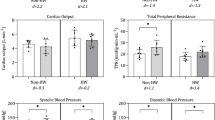Abstract
Previous studies have suggested that increases in skin blood flow (SkBF) are the primary physiological mechanism responsible for cardiovascular drift during exercise in the heat. Most of these studies, however, used exercise bouts of 60 min in duration or less. The purpose of this study was to explore the possibility that during prolonged (> 60 min) exercise in the heat, cardiovascular drift can occur without a concomitant increase in SkBF. The subjects were five heat-acclimated female volunteers. Each subject completed a 6-h heat exposure (38oC, 62% RH). Heart rate (HR), stroke volume (SV), and two independent measures of SkBF were obtained each hour. Cardiovascular drift occurred, as evidenced by a significant (p<0.05) 19% increase in HR and a significant 21% decrease in SV. Interestingly, however, SkBF plateaued by hour 2 and showed no further increase. Such results suggest that during prolonged exercise in the heat, when SkBF has reached very high values (>20 ml / 100 ml per min) and plateaued, cardiovascular drift can still occur.
Similar content being viewed by others
Author information
Authors and Affiliations
Corresponding author
Rights and permissions
About this article
Cite this article
Buono, M.J., Heaney, J.H., Cline, J.A. et al. Cardiovascular drift can occur without a concomitant increase in skin blood flow. EBO 1, 1–5 (1996). https://doi.org/10.1007/s00898-996-0007-y
Received:
Accepted:
Published:
Issue Date:
DOI: https://doi.org/10.1007/s00898-996-0007-y




